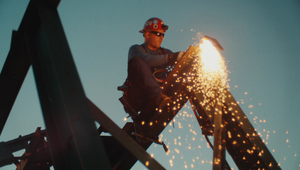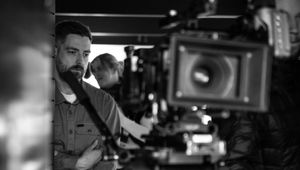
LBB Film Club: Meet Me At The Stairs

At the age of 21, Jesse Hunt's life was saved by a kidney transplant. His dad had selflessly donated one of his kidneys to a stranger so that Jesse could receive one from another party in return. But that life-saving surgery and the medications that Jesse takes to ensure its success mean that he is immunosuppressed and particularly vulnerable during the pandemic. What's more, Jesse's wife is an essential emergency worker for Toronto Paramedic Services. The pair have been living in isolation from each other for more than 46 days.
Jesse is a filmmaker, repped in Canada by Sequoia Content, and set about making a film that explores the anxiety that comes with being an essential worker during a worldwide pandemic and coping with the sacrifices you must make to keep your family members safe. The end result is 'Meet Me At The Stairs', a beautiful piece of raw filmmaking that will certainly resonate with most who watch it.
"The film is dedicated to my wife and all essential workers that are making a sacrifice during this uncertain time," says Jesse. LBB's Addison Capper chatted with him to find out more about the process of shooting it.
LBB> When you decided that you wanted to make something for your wife and other key workers, what were your starting points? Were you quite fixed on a concept early on?
Jesse> I had a very loose idea for what the story could be. I knew that our living situation was both unique in a sense but also relatable to most people. We are all dealing with the pandemic in different ways, which is the common thread, this just happens to be our way of doing it. I also realised that there was a lot of discussion and content surrounding the sacrifices that our front line and essential workers are making by physically going to work but not a lot exploring how those sacrifices impacted their home lives. That was the angle that I found most interesting, perhaps because I was experiencing it first hand.
LBB> What did that concept look like? Was it quite a fluid process because it was close to home or did you nail it down quite firmly?
Jesse> I knew that the story had to be told from my wife’s perspective. Even though I am the one that is immunocompromised and technically at a higher risk, seeing how the separation from each other and the anxiety that my wife was dealing with from coming home every day made it very clear to me that this had to be routed in her experience.
Since I filmed it over a two-week period there was never any rush to the process. It really allowed for the project to develop naturally and I honestly never felt like I was struggling to find a direction for it. It all unfolded very naturally and while I was editing, if I needed a shot that was outside of my initial shot list, I’d just go shoot it.
The one shot that seems to be resonating with people the most is of Lindsay and I sitting at the stairs together, looking at each other from a first person point of view. I had finished what I thought was the final version of the film and then realized that I needed that shot. It was a powerful visual that gave context to the idea of being so close, but still so far from each other.
LBB> Given that you are distancing from your wife at the moment, how did you pull off the production and the scenes that feature her?
Jesse> Lots of trial and error. If we were ever close to each-other, which wasn’t often, I was masked up and wearing gloves. I used long lenses as much as I could so I could stay a decent distance away or I would line up the shot as best I could without Lindsay being there, hit record, leave the room and have her come into the frame. There were lots of out of focus shots and tons of extra material since the camera was rolling so much. For the interview portion, which we did over two separate days, I set everything up and would leave the room so Lindsay could take her mask off, using FaceTime to ask the questions or I’d speak loud from the hallway.
LBB> How did you find the process of directing your wife and her voiceover? Was it quite a natural experience?
Jesse> I wouldn’t say it was natural. I think I had a very specific idea of what I wanted the voiceover to feel like and at the moment it didn’t feel like we were getting it. I think it’s difficult telling a story like this, that you’re so close to, with someone that is right there in it with you. We were both just trying to figure out this new way of living with each other and here I am trying to force my wife to rationalise it all, her thoughts and feelings in front of a camera.
I feel for her and I’m very appreciative of her patients and that she endured the hours I asked her to put into it. At the time I knew it was stressful, we were both feeling it during the interview but she stuck with it and now that the film is finished, appreciates how our story is being presented. We’ve already started looking back on the process and it feels very special that she was able to be such a huge component in a project that means so much to the both of us. It gave her a glimpse into how my brain works…
LBB> I get very warm vibes from the aesthetic and grade. It's an emotional story but somehow there's a warmth to it. What were your main aims when it came to that element of the film?
Jesse> Right from the beginning I knew that the story, the way I shot it and how I wanted the overall aesthetic of the film to appear would have a sense of rawness to it. I knew that shooting it at a 4:3 aspect ratio would perhaps give it a bit of a nostalgic vibe but wanted it to have a very analogue, film-like appearance. Once the edit was done, I did a very rough pass on the colour grade and shared it with a friend of mine, Ana Escorse, who has such an amazing style that I really resonate with. She took one look and offered to do a pass on it which I will forever appreciate. That is one element that people keep commenting on. How the grade really compliments the rawness and the emotion of the film as a whole, which I would imagine is the main goal. I’m so glad that Ana was willing to take a stab at it as it really gave the film a distinctive visual style.
LBB> Not being able to be close to your loved one is a difficult experience. Emotionally how did you find the challenge of addressing that within this film?
Jesse> I had to compartmentalise it a bit. Obviously I didn’t want to completely ignore the emotion that comes naturally from telling a story that hits so close to home because it does play a role in how things like this are crafted, but, that can also become distracting. This happened without me realising it for the most part, whether that was a subconscious decision, I’m not sure.
During the interview when Lindsay actually begins to cry, saying that she just wants a hug, was certainly the most difficult interview I’ve ever done. I had to tell myself to keep quiet, look away and let the moment play out, even though all I wanted to do was get up and comfort her. I did have plenty of time to feel and absorb that emotion while I was editing, though.
LBB> What were the trickiest components and how did you overcome them?
Jesse> The hardest parts were probably filming the shots while maintaining a safe distance from each other. I was constantly battling the idea of ‘just getting the shot’ and ‘no, stay safe or you’re a hypocrite for doing this film in the first place’.
Also filming myself. Again, lots of out of focus shots and lots of trial and error.
I didn’t tell Lindsay I had been working on it in the background so she had no idea where I was in the process. I shot a lot of the empty room shots and shots of myself without her knowledge. When the film was finished I showed it to her as a surprise which was a really great experience to share.
LBB> Any parting thoughts?
Jesse> We’re all in this together, which sounds horribly cliche but it’s true. This film was for Lindsay but I also constantly had the idea in my mind that it was for every essential worker out there.
Getting feedback from people saying that this was a helpful reminder for them. We are heading into phase two of re-opening here in Ontario, and we have to continue practicing safe social habits because at the end of the day there will always be people at risk based on our actions. Not just our friends and families but essential workers that don’t have a choice in the matter. They will be the ones risking it all to look after us if we are irresponsible.












